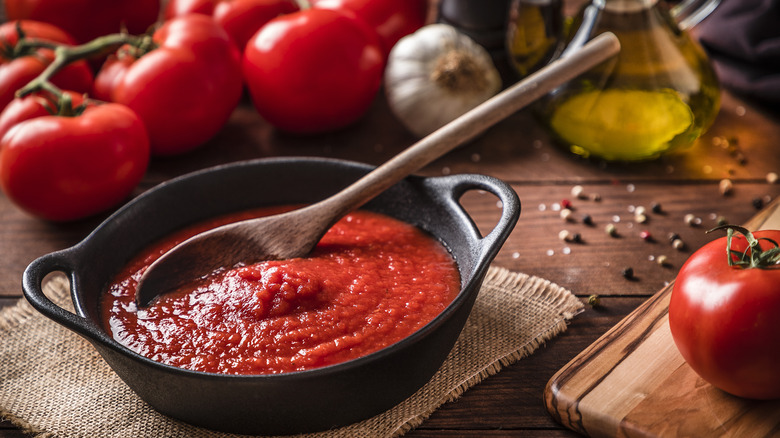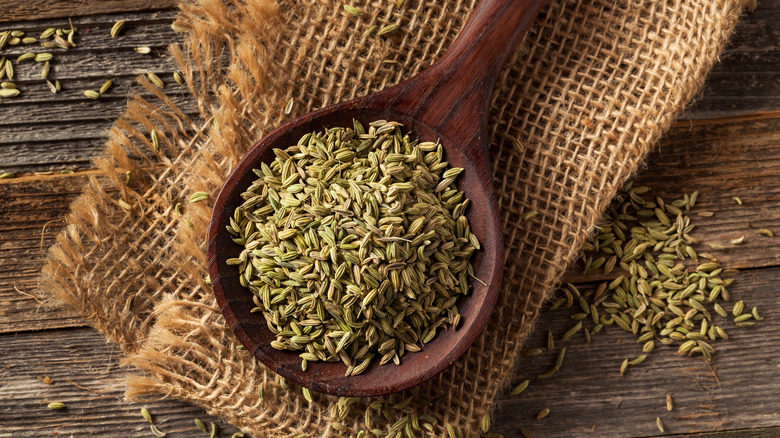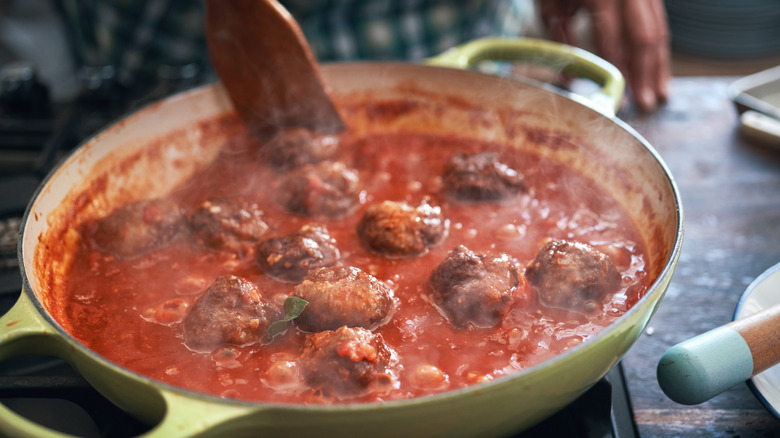The Spice You Should Be Adding To Tomato Sauce (Hint: It's Not Garlic Powder)
A good tomato sauce doesn't need to be complicated, but it must have character. A punchy marinara or rustic tomato sauce only needs fresh bread to become an incredibly satisfying meal. Add some herbs and garlic, and you've got a light pasta sauce; some diced onion turns it into a chunky pizza sauce. This versatility stems from the base ingredient — the (not so) humble tomato, and we'll explore the many ways to bring out its myriad flavors in a sauce soon enough.
First, let's start with an ingredient that's regularly used in traditional Italian cooking but hasn't received the universal recognition enjoyed by other tomato sauce flavoring components like garlic or basil. Fennel has a herby, spicy flavor reminiscent of licorice, which can be mild or intense depending on what part of the plant you use. A small amount of crushed fennel seeds adds complexity and sweetness to tomato sauce while contrasting and complementing the tomato's deeper, earthier flavors.
Often used in traditional Italian sausages, fennel seeds give the sauce a touch of authenticity and elevate it from regular tomato sauce. The next time you make a batch, add some fennel and enjoy how it makes your tomato sauce come alive.
Fennel is an authentic Italian spice that elevates tomato sauce
Like tomatoes, fennel's flavor walks the line between savory and sweet but also includes notes of licorice spice that blend well with the sauce's acidity. Traditional Italian dishes use the spice plant's leaves, stems, flowers, and seeds in various recipes, along with mushrooms, olives, and even boiled chestnuts. However, fennel seeds are most often used to flavor cured meats, particularly pork. Therefore, anyone familiar with traditional Italian cuisine will likely recognize the distinctive taste.
Because of this characteristic flavor, you only require a small amount, which have a stronger flavor than the plant's leaves and stem. Gently toast the seeds and finely chop or grind them before adding them to the sauce. For a lighter flavor, add them at the start. If you enjoy those notes of fennel in your sauce, you can add them later in the recipe to make them more prominent. In a pinch, you can also use anise as a substitute but do so cautiously because it has a much stronger licorice flavor.
Fennel-spiced tomato sauce is as versatile as regular tomato sauce. You can use it over pasta, meatballs, pizza, or for dipping. It also makes an excellent base for bolognese sauce and pairs nicely with grilled meats and fish.
More ways to boost homemade tomato sauce
Despite their ubiquitousness, tomatoes are intriguing ingredients that contain an astounding variety of flavors. Their sweet, tangy, and juicy attributes are well known, but they also contain umami notes and the potential to develop a deep, rich taste when simmered. You can choose which aspects of tomatoes you want to bring to the forefront by choosing specific flavoring ingredients.
Chef Giada De Laurentiis suggests adding leftover parmesan rinds to the pot while your tomato sauce simmers, infusing it with the aged cheese's subtle nutty notes. Adding a splash of fish sauce to tomato sauce brings out umami notes to give your sauce a satisfying mouthfeel. The translucent jelly-like tomato pulp (which holds the tomato seeds) also contains intense umami flavors, so include it in the sauce instead of discarding it.
To give your tomato sauce a deeper flavor, roast tomatoes, garlic, and herbs in the oven with olive oil before blending them. On the other hand, add a touch of sugar or agave syrup for a lighter, sweeter sauce to use in summer pasta. You can also take the flavor of your sauce in a fruitier, sweeter direction by using cherry or grape tomatoes. Because they combine sweet and spicy notes, fennel seeds taste equally good in a rich, slow-cooked gravy or a bright and zesty one.


